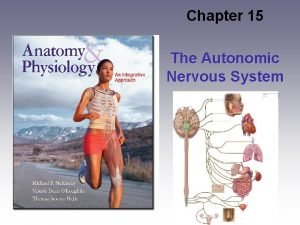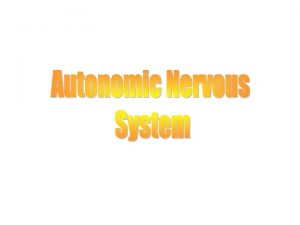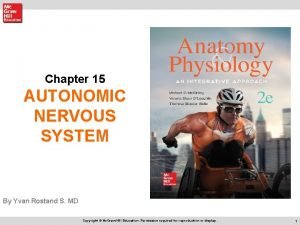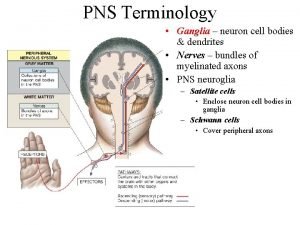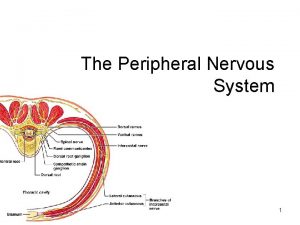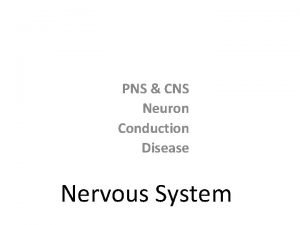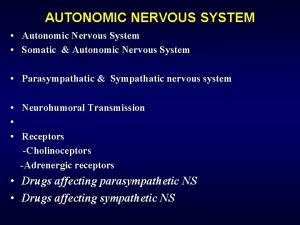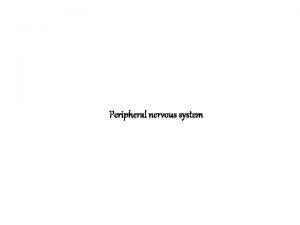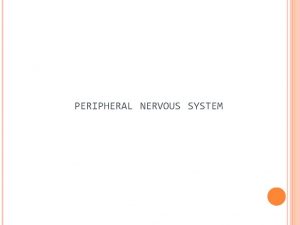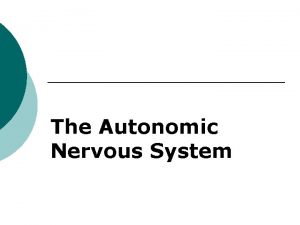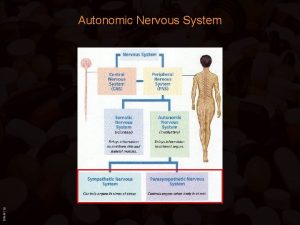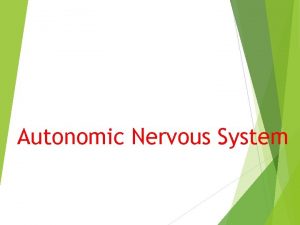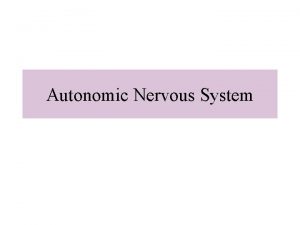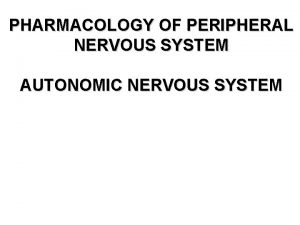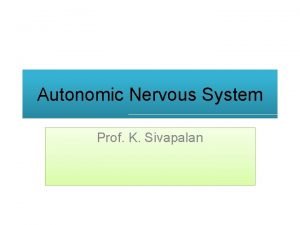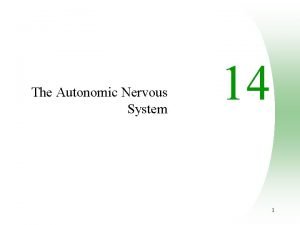Peripheral Nervous System 2 The Autonomic System 12
















![Visceral Afferents and Referred Pain dorsal root ganglion Visceral sensory nerves [GVA] • run Visceral Afferents and Referred Pain dorsal root ganglion Visceral sensory nerves [GVA] • run](https://slidetodoc.com/presentation_image_h/35d14d179c01a80bcf8cc8496ceeccba/image-17.jpg)



- Slides: 20

Peripheral Nervous System 2: The Autonomic System 12 August 2013 Reading: Moore’s ECA 4 36– 43 Lawrence M. Witmer, Ph. D Professor of Anatomy Dept. of Biomedical Sciences Heritage College of Osteopathic Medicine, Ohio University Athens, Ohio 45701 witmer. L@ohio. edu

Somatic vs. Visceral attribute Somatic System Visceral System embryological origin of tissue “body wall: ” somatic (parietal) mesoderm (dermatome, myotome) “organs: ” splanchnic (visceral) mesoderm, endoderm examples of adult tissues dermis of skin, skeletal muscles, connective tissues glands, cardiac muscle, smooth muscle perception conscious, voluntary unconscious, involuntary Langman’s Embryo 9 2004

Sensory/Motor + Somatic/Visceral Somatic Visceral Sensory (Afferent) somatic sensory visceral sensory [General Somatic Afferent (GSA)] [General Visceral Afferent (GVA)] Motor (Efferent) somatic motor visceral motor [General Somatic Efferent (GSE)] [General Visceral Efferent (GVE)] Somatic Nervous System Autonomic Nervous System (July 29) (today)

Overview of the Autonomic Nervous System Similarities between Sympathetic & Parasympathetic • Both are efferent (motor) systems: “visceromotor” • Both involve regulation of the “internal” environment generally outside of our conscious control: “autonomous” • Both involve 2 neurons that synapse in a peripheral ganglion • Innervate glands, smooth muscle, cardiac muscle glands CNS ganglion smooth muscle preganglionic neuron postganglionic neuron cardiac muscle

Overview of the Autonomic Nervous System Differences between Sympathetic & Parasympathetic Location of Preganglionic Cell Bodies Sympathetic Parasympathetic Thoracolumbar Craniosacral T 1 – L 2/L 3 levels of the spinal cord Brain: CN III, VII, IX, X Spinal cord: S 2 – S 4

Overview of the Autonomic Nervous System Differences between Sympathetic & Parasympathetic Relative Lengths of Neurons Sympathetic CNS target ganglion short preganglionic neuron long postganglionic neuron Parasympathetic CNS long preganglionic neuron ganglion target short postganglionic neuron

Overview of the Autonomic Nervous System Differences between Sympathetic & Parasympathetic Neurotransmitters NE (ACh at sweat glands), Sympathetic ACh, + + / -, α & ß receptors • All preganglionics release acetylcholine (ACh) & are excitatory (+) • Symp. postgangl. — norepinephrine (NE) & are excitatory (+) or inhibitory (-) • Parasymp. postgangl. — ACh & are excitatory (+) or inhibitory (-) • Excitation or inhibition is a receptor-dependent & receptor-mediated response Parasympathetic ACh, + Potential for pharmacologic modulation of autonomic responses ACh, + / muscarinic receptors

Overview of the Autonomic Nervous System Differences between Sympathetic & Parasympathetic Target Tissues Sympathetic Parasympathetic • Organs of head, neck, trunk, & external genitalia • Adrenal medulla • Sweat glands in skin • Arrector muscles of hair • ALL vascular smooth muscle » Sympathetic system is distributed to essentially all tissues (because of vascular smooth muscle) » Parasympathetic system never reaches limbs or body wall (except for external genitalia)

Overview of ANS Functional Differences Sympathetic • “Fight or flight” • Catabolic (expend energy) Parasympathetic • “Feed & breed”, “rest & digest” • Homeostasis » Dual innervation of many organs — having a brake and an accelerator provides more control

Structure of spinal nerves: Somatic pathways dorsal ramus dorsal root ganglion dorsal root spinal nerve dorsal horn CNS interneuron somatic sensory nerve (GSA) ventral somatic ramus motor ventral horn nerve ventral root Mixed Spinal Nerve gray ramus communicans sympathetic ganglion (GSE) white ramus communicans

Structure of spinal nerves: Sympathetic pathways dorsal ramus intermediolateral gray column spinal nerve ventral ramus gray ramus communicans sympathetic ganglion white ramus communicans

Sympathetic System: Preganglionic Cell Bodies • Preganglionic cell bodies in intermediolateral gray • T 1 – L 2/L 3 • Somatotopic organization somatic tissues (body wall, limbs) visceral tissues (organs) intermediolateral gray columns T 1 – L 2/L 3 lateral horn Clinical Relevance » dysfunction due to cord injury » spinal nerve impingement & OMM » referred pain Moore’s COA 6 2010

Sympathetic System: Postganglionic Cell Bodies 1. Paravertebral ganglia • Located along sides of vertebrae • United by preganglionics into Sympathetic Trunk • Preganglionic neurons are thoracolumbar (T 1–L 2/L 3) but postganglionic neurons are cervical to coccyx • Some preganglionics ascend or descend in trunk Paravertebral ganglia sympathetic trunk (chain) synapse at same level Prevertebral ganglia • celiac ganglion • sup. mesent. g. • inf. mesent. g. ascend to synapse at higher level descend to synapse at lower level aorta Moore’s COA 6 2010

Sympathetic System: Postganglionic Cell Bodies 2. Prevertebral (preaortic) ganglia • Located anterior to abdominal aorta, in plexuses surrounding its major branches • Preganglionics reach prevertebral ganglia via abdominopelvic splanchnic nerves Paravertebral ganglia sympathetic trunk (chain) Prevertebral ganglia abdominopelvic splanchnic nerve • celiac ganglion • sup. mesent. g. • inf. mesent. g. aorta Moore’s COA 6 2010

Sympathetic System: Summary visceral tissues (organs) Cardiopulmonary Splanchnics: postganglionic fibers to thoracic viscera somatic tissues (body wall, limbs) T 1 postganglionics via 31 spinal nerves to somatic tissues of neck, body wall, and limbs sympathetic trunk Moore’s COA 6 2010 Abdominopelvic Splanchnics: preganglionic fibers to prevertebral ganglia, postganglionic fibers to abdominopelvic viscera L 2 prevertebral ganglia

Parasympathetic Pathways Cranial outflow • CN III, VII, IX, X • Four ganglia in head • Vagus nerve (CN X) is major preganglionic parasymp. supply to thorax & abdomen • Synapse in ganglia within wall of the target organs (e. g. , enteric plexus Sacral outflow of GI tract) • S 2–S 4 via pelvic splanchnics • Hindgut, pelvic viscera, and external genitalia Clinical Relevance » Surgery for colorectal cancer puts pelvic splanchnics at risk » Damage causes bladder & sexual dysfunction Moore’s COA 6 2010
![Visceral Afferents and Referred Pain dorsal root ganglion Visceral sensory nerves GVA run Visceral Afferents and Referred Pain dorsal root ganglion Visceral sensory nerves [GVA] • run](https://slidetodoc.com/presentation_image_h/35d14d179c01a80bcf8cc8496ceeccba/image-17.jpg)
Visceral Afferents and Referred Pain dorsal root ganglion Visceral sensory nerves [GVA] • run with sympathetic & parasympathetic nerves • cell bodies in dorsal root ganglion • nerve ending in viscera Somatic sensation: • conscious, sharp, well-localized • touch, pain, temperature, pressure, proprioception Visceral sensation: • often unconscious; if conscious: dull, poorly-localized • distension, blood gas, blood pressure, cramping, irritants

Visceral Afferents and Referred Pain: • Pain originating in a visceral structure perceived as being from an area of skin innervated by the same segmental level as the visceral afferent • Results from convergence of somatic & visceral afferents on the same segmental level of the spinal cord convergence & • “Cross-talk” in the dorsal“cross-talk” horn somatic afferent www. merck. com visceral afferent Kandel et al. 2000

Visceral Afferents and Referred Pain Maps of Referred Pain Grant’s Atlas 12 2009

References Agur, A. M. R. and A. F. Dalley. 2009. Grant’s Atlas of Anatomy, 12 th Edition. Lippincott, Williams & Wilkins, New York. Kandel, E. R. , J. H. Schwartz, and T. M. Jessell. 2000. Principles of Neural Science, 4 th Edition. Mc. Graw-Hill, New York. Moore, K. L. , A. F. Dalley and A. M. E. Agur. 2010. Clinically Oriented Anatomy, 6 th Edition. Lippincott, Williams & Wilkins, New York. Sadler, T. W. 2004. Langman’s Medical Embryology, 9 th Edition. Lippincott, Williams & Wilkins, New York.
 Alpha 1 receptors
Alpha 1 receptors Somatic motor neuron
Somatic motor neuron Autonomic nervous system consists of
Autonomic nervous system consists of Ans
Ans Autonomic
Autonomic Autonomic nervous system
Autonomic nervous system The autonomic nervous system controls
The autonomic nervous system controls Craniosacral region
Craniosacral region Autonomic dysreflexia
Autonomic dysreflexia Major division and parts of the nervous system
Major division and parts of the nervous system Neuron process
Neuron process Sensory input and motor output
Sensory input and motor output Nerve cell process
Nerve cell process Ganglion peripheral nervous system
Ganglion peripheral nervous system Nervous system major divisions
Nervous system major divisions Peripheral nerves and nerve plexuses
Peripheral nerves and nerve plexuses Nervous system divisions
Nervous system divisions Hydras
Hydras Peripheral nervous system consists of
Peripheral nervous system consists of Youtub.eoc
Youtub.eoc Involuntary movements
Involuntary movements





